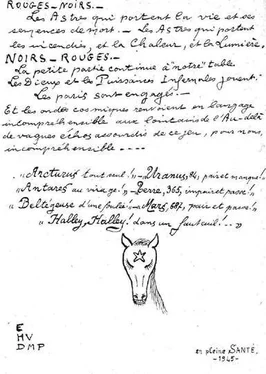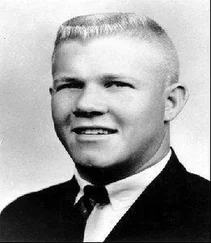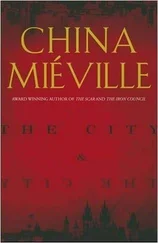The timing of the funeral and the presence of the strange men at his side, on the other hand, suggest that the Gestapo men of office IV B-4 might well have released Petiot in order to follow him—not, as Petiot said at his interrogation, to arrest his so-called Resistance comrades, but rather to track down his treasure. Given that these Gestapo men sometimes tried to profit from their positions of authority, and unquestionably suspected that Petiot had accumulated a fortune, it is difficult to imagine that they would not have tried to lay their hands on it. A token payment would suffice to free their prisoner, and then Jodkum’s men could follow him to the real source of his wealth, which Jodkum had hoped to seize from the moment they began seriously to investigate Dr. Eugène’s organization.
Perhaps this attempt to conceal the treasure gives insight into another curiosity about the Petiot case that has never been adequately explained: the dangling panels, the ripped-up floorboards, cut-open divans, and holes in the walls found at rue Le Sueur when the French police arrived on March 11, 1944 (and later, too, at rue des Lombards in Auxerre). Was this evidence of a search of Petiot’s property for concealed wealth?
But by whom? The Gestapo? As remarkable as it sounds given their interrogations and attempts to follow him after prison, there is no evidence that Jodkum and his men actually knew of his property at 21 rue Le Sueur before March 11. Someone else in Occupied Paris, however, did, and this brings us back to the men who accompanied Petiot to the funeral. Clearly they seem to have been providing protection, as one of them later admitted, and their identity would suggest that whatever Petiot carried in those suitcases was of significant value. This is because one of the men with the physician was Abel Danos, “The Mammoth” or “The Bloodthirsty.”
A giant, cruel man with a long history of burglaries including a famous train robbery in 1936 and the first major holdup of the Occupation, a coup in February 1941 that resulted in some 8 million francs, Danos served the gangster Henri Lafont. In fact, Danos was one of Lafont’s most valued toughs, belonging to the crime boss’s inner circle or “war council” and selected to take on Lafont’s most important tasks. The other men in Petiot’s entourage—Gé les Yeux Bleus, François-le-Marseillais, André or Dédé-la-Mitraillette, Jo la Remonte—also worked for Lafont.
So if the coffin at Joigny might take us one step farther in seeing how Petiot dispersed his wealth, it does not ultimately reveal the fate of his treasure, which, alas, remains unknown. What it does offer, however, is support for an allegation first made by Adrien the Basque’s brother, Emile Estébétéguy, of a Petiot-Lafont connection. Estébétéguy, also a member of Lafont’s gang, claimed that Lafont had sent Adrien the Basque to Petiot. Lafont officially denied any knowledge of Petiot or rue Le Sueur, and the physician’s name never appeared on the list of payments made by the French Gestapo. Nevertheless, it is not difficult to establish links between the two men.
One of Dr. Petiot’s patients was Paul Jean Marie Joseph Clavié, a short, violent man who showed up at his office on rue Caumartin in the late 1930s, probably 1938, for treatment of gonorrhea. Clavié, then aged twenty-three, had selected Petiot, he said, because he was a respected “physician of the pissoir.” Clavié was at this time a small-time hoodlum. A couple of years later, however, he was one of the most powerful men in the criminal underworld. Clavié was the nephew of Henri Lafont.
Lafont had, at this time, no immediate family, and he treated Clavié almost like a son. On January 10, 1941, while on an early mission with Lafont to establish an espionage center with radio transmitter-receptor at Cap Doumia, outside Algier, Clavié wrote a letter to Dr. Petiot, concluding with the postscript “my uncle greets you and will see you on his return.” Lafont had just received permission from the Abwehr to expand his gang, along with hundreds of thousands of francs to finance his search for new recruits. By April 15, 1941, he was back in Paris doing just that, and by the end of May, he had moved into his office at rue Lauriston. That was the same week that Petiot purchased the property at rue Le Sueur. The physician paid the bulk of the price in cash, the source of which neither he nor anyone has ever been able to explain.
This, of course, does not mean that Lafont supplied or secured any of the funds for the town house. But assuming for the moment that Petiot could have raised the money from the profits of his medical practice, antiques dealing, and other assets, which is by no means certain, it is striking that he would choose to invest in that particular location. The Germans had already requisitioned numerous buildings in the neighborhood. What made Petiot so sure his newly purchased property would be immune from the ever-expanding ambitions of Occupation authorities to take over buildings in that area?
Oral testimony from a former member of the French Gestapo suggests that the relationship between Petiot and Lafont developed more significantly the following year. In early 1942, after breaking up a false escape organization in Tournus that pretended to take Jews across the line of demarcation (run by a police inspector who brought down the anger of the Germans when he stopped sharing his profits), the French Gestapo had been encouraged to continue this work, more actively seeking passeurs and escape organizations alike. By the early summer, an informer reported another such agency run by an unidentified physician who helped people escape Occupied Paris. Lafont’s associate, Pierre Bonny, decided to investigate.
He sent three British men, who had served the gang since their desertion, to pose as downed Royal Air Force pilots hoping to flee to Spain. After a lengthy process, including help from Eryane Kahan to arrange the meeting, the physician, Dr. Eugène, received the pilots, heard their pleas, and then promptly doubled the asking price to 50,000 francs apiece. At the next meeting, in late June 1942, also arranged by Kahan, Bonny sent a team to follow the false pilots. Dr. Eugène inadvertently led the thugs straight to rue Le Sueur.
The men seized the physician, threw him to the ground, and snapped handcuffs on his wrists. At this point, Paul Clavié and an associate, Pierre Loutrel (later the notorious “Pierrot-le-Fou”), arrived, each wielding two pistols. Clavié was astonished. Dr. Eugène of the underworld was none other than his friend Marcel Petiot. The physician was released. With the tension diffused, Petiot offered everyone a drink. Before leaving rue Le Sueur, Bonny decided to take a look around the town house. It was his turn to be shocked. He saw jars with genitals in Formol, and two bodies in the process of being chopped up in the basement. Lafont, hearing of the butchery, apparently realized that he could make use of this doctor’s scalpel and his willingness to wield it.
Lafont could not only take a cut from the profitable escape agency, but also use the opportunity to extend his reach farther. For instance, when a gang member committed a breach of confidence that could not be atoned for with the payment of a fine (he charged 1,000 to 10,000 francs for minor infractions), he soon realized that the only way to escape Lafont’s wrath was to follow Jo the Boxer, Adrien the Basque, and their colleagues out of Occupied Paris. Alternatively, if Lafont did not want to make an example out of the offender, he could magnanimously allow that person to escape with his life, provided he left the country. Either way, Lafont would win, punishing irregularities that threatened to undermine his discipline and, at the same, turning a profit. And given the valuables that many gangsters were certain to carry, this could be substantial.
Читать дальше












